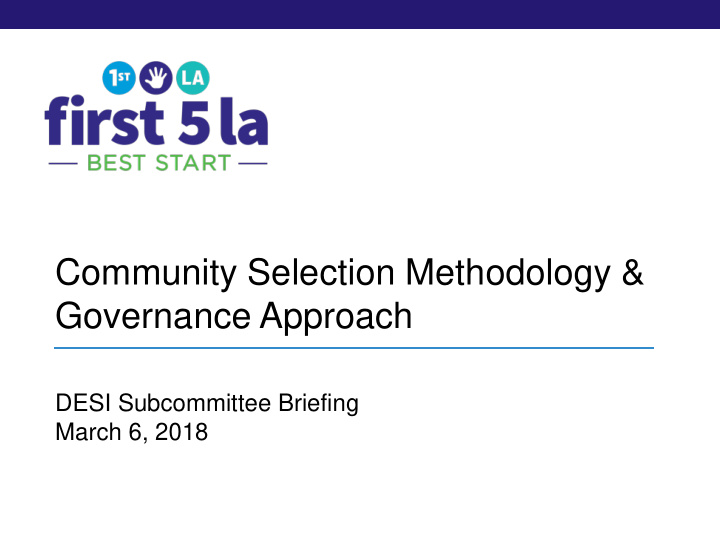



Community Selection Methodology & Governance Approach DESI Subcommittee Briefing March 6, 2018
Presentation Objectives Increase understanding of the following: Selection Criteria & Model for Best Start Communities Governance Structure for Best Start (2009 – early 2018) Governance Structure for Best Start (2018 - )
Place-Based Approach First 5 LA will direct its funding to specific target communities Funding will include direct services and community capacity building activities Places where children live are strong influencers on their ability to be safe, healthy and ready to learn Began under FY 2009-2015 Strategic Plan Renewed Commitment in the FY 2015- 2020 Strategic Plan
Community Selection Principles Data-Driven High-Need Communities Prioritize High-Need Communities based on their Strength and Capacity Respect for Natural Community Boundaries Representation of Diverse Populations & Regions
Community Selection Process Assess Community Need Assess Community Consider Diversity Capacity Level I, Part 1 Level I, Part 2 Level II Level III Analyzed: Refined analysis by using Analyzed qualitative data Considered community • BSLA Indicators indicators most supported gathered from: diversity by examining: • Birth rate • • by available data and/or F5LA staff focus groups with Distribution of • Level of F5LA program officers communities across LA literature review to identify investments • Community focus groups County Sup. Districts risk and need (as it pertains • • Key informant interviews Racial/ethnic population to F5LA mission) distribution among communities Analyzed quantitative data Key Findings: • Diverse levels of gathered on: • Need is not consistent capacity • Infrastructure indicators across the county • Investment indicators • Sup. Districts 1 and 2 had more high need Note: Level 3 is a Placed communities on a communities than other consideration applied continuum based on capacity districts during all levels of the community selection 24 high need communities methodology were consolidated to 19 based on focus group feedback
Best Start Communities (2009 - early 2018) 1. Broadway-Manchester 2. Central Long Beach 3. Compton-East Compton 4. East Los Angeles 5. Lancaster 6. Metro LA 7. Northeast Valley 8. Palmdale 9. Panorama City & Neighbors 10.Southeast LA 11.South El Monte/El Monte 12.Watts-Willowbrook 13.West Athens 14.Wilmington
Partnership Support Structures (2009 – early 2018) Per Community and Countywide Central Long Southeast LA Palmdale Beach LEAD AGENCY Para los Niños Broadway- East LA Lancaster Manchester Watts- Panorama Wilmington Willowbrook City Metro LA Northeast Compton- West Athens Valley East Compton 1 Community South El Monte/ El Monte 13 Communities
A New Structure for Best Start Design Principles Aligns mission, strategy, and operations Promotes Allows for accountability flexibility & & efficiency scalability Design Principles Fosters Considers collaboration key & network stakeholder building perspectives
9 Design Parameters First 5 LA a partner, not a doer Costs reasonable and effective Not creating new entities Decisions made in context of First 5 LA’s fiduciary responsibility Decisions informed by multiple inputs and engagement Mutual commitment to authentic Partnership
Geographic Considerations • Proximity Parameters: • Supervisorial District • • Shared Infrastructure More than one community per region • Service Planning Area • Manageability within • Potential for Cross- region Community Learning • • Shared History Each community within a region receives the • Community Feedback resources they need to support the work
Best Start Communities (2018 - ) Region 1 : East Los Angeles, South El Monte/El Monte, Southeast LA, Metro LA Region 2 : Broadway-Manchester, Compton-East Compton, Watts- Willowbrook, West Athens Region 3 : Northeast Valley, Panorama City & Neighbors Region 4 : Central Long Beach, Wilmington Region 5 : Lancaster, Palmdale
New Structure: Regional with Local Customization (2018 - ) East LA Local Support Network Org 1 Org 2 Org 3 South El Monte/ Central-East El Monte Southeast LA Regional Network Local Support Network Local Support Network Supports 4 regional functions with Org 1 Org 1 subcontracts to local organizations to fulfill operations and community change Org 2 Org 2 work Metro LA Local Support Network Community Organizing and Advocacy Org 1 Communications Org 2 Community Identified Projects Resident Engagement Org 3 Learning Coordination and Support Local Resource Management & Mobilization
Key Considerations for Community Selection & Governance Use data to inform decisions Start with principles and parameters Include community voice & promote community ownership Consider size and boundaries of geographic areas Build on community strengths
Thank You!
Recommend
More recommend